Compassion and Sustainability: A Whole Foods Plant Based Diet to Mitigate the Metacrisis
Part 1 - Personal Insights
“An ounce of prevention is worth a pound of cure.”
Benjamin Franklin
My ethical ideal is an extrapolation of a proposed behavior for all living human beings. While ideals are aspirational and not always realistically attainable, they can refine our actions over time. This extrapolation takes the form of two guiding questions: "If all humans behaved in this manner, what would the planet look like?" and "If all humans behaved in this manner, what would the lived experience of sentient beings be like?" These questions are specifically designed to elicit both inductive and imaginative, visual and somatic insights.
I've applied these inquiries to various aspects of my life, from daily routines to career choices. What I've consistently found is that many behaviors normalized by our consumer-driven, exploitative, fossil-fueled culture are, in fact, laying the groundwork for dystopian futures. While few consciously desire to create such a future, our unexamined choices—especially those tied to material consumption—can collectively generate destructive momentum, even in seemingly mundane decisions when considered over a lifetime.
Applying this ethical lens to my diet, in particular, has led to significant personal discoveries. It’s illuminated the nature of energy, the physics of energy transfer through food, and what I believe is the fundamental intention behind the Golden Rule, echoed across diverse spiritual traditions worldwide.
The Physics of Energy Transfer
Contemplating "if all humans behaved in this manner, what would the planet look like" led me back to basic biology classes and the concept of trophic levels (Energy Flow and Trophic Levels, n.d.). A fundamental principle is the logarithmic loss of energy at each successive trophic level. For example, autotrophs (organisms that can produce their own food using sunlight, carbon, water etc) absorb 10,000 kilocalories (kcal) of energy from the sun, but primary consumers receive only 1,000 kcal when consuming these autotrophs. The greatest energy efficiency, therefore, comes from composing the majority of one's diet directly from plants, minimizing energy loss.

A group of researchers in France recently quantified the trophic levels of various countries, providing a clear scale for understanding dietary energy flow:
Primary producers, such as plants or phytoplankton, are defined as trophic level 1 (1, 4). Subsequent trophic levels are then calculated as a mean of the trophic levels of food items in a species’ diet, weighted by quantity, plus one. For example, herbivores such as cows feed on plants (trophic level 1); thus, their trophic level is 2. Similarly, a species whose diet is composed of half plant and half cow has a trophic level of 2.5 . Therefore, a 0.5 difference in trophic level can reflect a completely different diet, e.g., from herbivory to omnivory. For carnivorous apex predators, such as polar bears or killer whales, trophic levels range up to 5.5 (Bonhommeau et al., 2013)
The United States' average dietary trophic level is approximately 2.6, close to Iceland's highest reported current level of 2.57. With the U.S. population of 333 million consuming an average of 3,862 kcal per person per day, total daily consumption is approximately 158.54 billion kcal. If for just one day, everyone in the U.S. adopted a plant-based diet, we would realize a gain of approximately 118.72 billion kcal that would otherwise be lost to the inefficiency of animal agriculture. This simple math reveals the staggering consequences of seemingly mundane dietary choices when considered on a societal scale.
Because a growing majority of the world’s population chooses to consume without full consideration for the planet's physical boundaries, we've collectively deforested approximately 30% of the Earth's land, much of it ecologically vital areas like the Amazon rainforest, primarily to graze livestock. If this trend of meat consumption continues, one can easily envision a future where few forests remain, clear-cut and burned to make way for a flattened, fenced, endless terrain dedicated to grazing animals.
Our Evolutionary History
There is considerable evidence that omnivorous diets conferred benefits on humanity's evolutionary trajectory. From allowing infant brains to mature more quickly, making them less of a liability to nursing mothers, to providing nutrient-dense caloric input within a smaller hunting range and during periods of scarcity, meat consumption played a propitious role. Omnivorous diets also likely contributed to higher rates of encephalization when living in grasslands where grazing animals were the primary food source and plant-based proteins, typically available in forested regions (like roots and nuts), were less common. Meat is nutrient-dense, providing significant protein and micronutrients in a smaller volume of food, which was particularly useful for beings with higher energy demands and smaller stomachs, such as growing children.
However, with leaps in human nutrition and advanced supply chain logistics in the developed world, we've been able to develop plant-based diets that provide equivalent levels of protein and micronutrients through enrichment and supplementation. A consciously curated plant-based diet is nutritionally adequate for individuals of any age, provided they have easy access to the necessary constituents. We’ll discuss in greater detail in subsequent sections the environmental and health considerations when planning one’s diet throughout a lifetime.
"Is it not a reproach that man is a carnivorous animal? True, he can and does live, in a great measure, by preying on other animals; but this is a miserable way, - as any one who will go to snaring rabbits, or slaughtering lambs, may learn, -- and he will be regarded as a benefactor of his race who shall teach man to confine himself to a more innocent and wholesome diet. Whatever my own practice may be, I have no doubt that it is part of the destiny of the human race, in it's gradual improvement, to leave off eating animals, as surely as the savage tribes have left off eating each other when they came in contact with the more civilized."
Henry David Thoreau

The Golden Rule
"So whatever you wish that others would do to you, do also to them."
Matthew 7:12

This pithy ethical teaching, echoed across six of the world’s major belief systems (Christianity, Judaism, Confucianism, Buddhism, Hinduism, and Islam), encourages empathic reasoning to refine behavior. We are invited to consider the experience on the receiving end of our actions as a measure of whether to proceed with them. This is the foundation of "right relationships," rooted in consent and reciprocity. When we recognize that all sentient beings are conscious and capable of experiencing pain, and we refrain from constructing arbitrary lines across race or species, we can easily empathically reason that if we do not wish to experience pain, we ought not inflict it on others. Most living beings have evolved an ability to recognize that recoiling and avoidance behaviors are indicators that an action is non-consensual and liable to cause harm. It is immediately evident to young children when other living beings are experiencing distress, and we are naturally moved to attempt to alleviate the cause of that distress. If we heed this innate compassionate response as informative to our ethics, then it's clear that consciousness evolves towards pleasure and away from pain. If we can accept this truth, we can move forward in the knowledge that living with compassion as a guiding principle will ultimately lead us towards a reality that is supportive of all life and the evolution of consciousness.





Your mix of scientific rigor, ethical reflection, and compassionate reasoning is so good and inspiring. Thank you for illuminating how our daily choices ripple outward both ecologically and morally.
Btw I also have a personal question I wanted to ask that I have left in your inbox. When you get time please check it out.